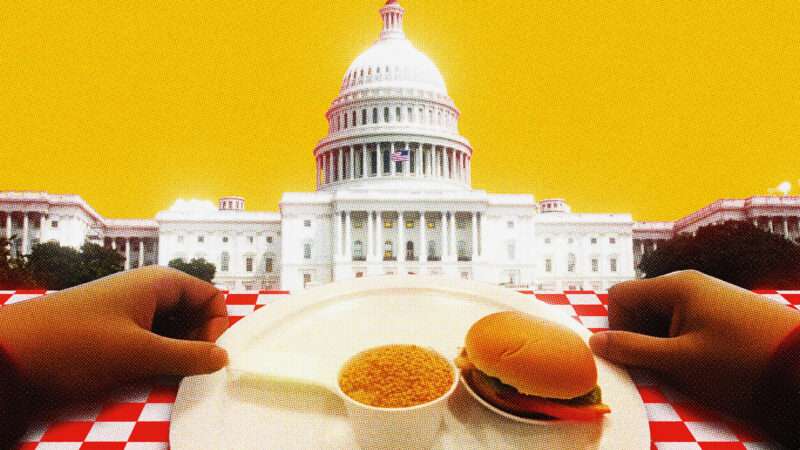
Thanksgiving week is a time to be grateful for the nutritional abundance you enjoy, and for many an appropriate time to think about how to help those who have so much less. A study released last month by the Cato Institute suggests that those who support U.S. government-to-foreign-government food delivery aid as the best means to ensure more abundant food access across the globe should think again.
The study, written by Chris Edwards, Colin Grabow, and Krit Chanwong, close-focuses on three specific food aid programs under the auspices of the U.S. Department of Agriculture and details their overarching flaws. These problems include that "US food aid can undermine agriculture in recipient countries and exacerbate conflicts in strife‐torn regions. Even in situations where food aid can reduce hunger, shipping US food abroad is an expensive way to help poor countries, particularly because of cargo preference rules requiring the use of US‐flagged ships. It is also usually slower to ship US food to needy countries than to procure it locally near aid recipients."
One program examined, Food for Peace, arose in 1954 mostly as a means to get rid of excess U.S. food production encouraged by government subsidies to American farmers. It involves direct shipping of food overseas, mostly for emergencies; the U.S. spent $2.28 billion on this in 2022. Another aid program, Food for Progress (2022 cost: $127 million), ships U.S. food abroad, not for direct giveaways to the hungry, but to be sold in foreign markets for cash that is then supposed to be used to help foreign development. A 2002 program known as McGovern-Dole (2022 cost: $193 million), as the Cato study explains, "donates food to schoolchildren and other groups in poor countries, while also helping countries expand their government food programs."
The study details some of the problems with these seemingly unobjectionable schemes of hunger philanthropy. These include harming local farmers trying to sell their products by displacing them in the markets where they need to sell to survive. A 2017 study cited by the Cato authors, written by Simon Gao and Barrett E. Kirwan of the University of Illinois at Urbana-Champaign, called "Does U.S. Food Aid Crowdout Local Food Production?" found that "U.S. cereal aid reduces cereal production in recipient countries… In terms of food aid quantity, if the average amount of food aid were to double, food aid would increase by 70,832 metric tons (MT) and production in the recipient country would fall by 173,952 MT."
Free food in certain foreign countries can just create a valuable thing to be fought over, militarily or in decisions about which elements in a country get cared for. As the Cato authors write:
In a statistical study covering the years 1971 to 2006 across 125 countries, Nathan Nunn and Nancy Qian found that "an increase in US food aid increases the incidence and duration of civil conflicts." Nunn and Qian explain, "Because food aid is regularly transported across vast geographic territories, it is a particularly attractive target for armed factions." Furthermore, "Governments that receive aid often target it to specific populations, excluding opposition groups or populations in potentially rebellious regions. This has been noted to increase hostilities and promote conflict."
…The problem with the USDA's aid programs is that they are rigidly based on shipping US‐sourced food that can be hijacked by warring parties and used to extend conflicts, which can be a counterproductive way to help troubled countries.
And far from being a quick way to deal with overseas food emergencies, "the lengthy amount of time needed for delivery reduces its usefulness. US food aid shipments typically take four to six months to reach destinations abroad."
The authors point out that aid programs that procure food in markets near where it's needed are far quicker and cheaper ways to deliver food aid, but are not beloved of domestic agricultural interests.
Policies designed to help domestic interests while supposedly meant to help hungry foreigners extend to how we deliver food aid overseas. As the study reports:
the Cargo Preference Act of 1954…requires that at least half the tonnage of government‐impelled cargo—including food aid—be shipped on US‐flagged vessels. Food for Peace, Food for Progress, and McGovern‐Dole must abide by these rules. Competition is limited among US‐flagged vessels, and they are about three times more expensive to operate than their foreign‐flagged counterparts.
According to economist Vincent Smith and Senator Jim Risch (R‑ID), the "overwhelming majority" of US food aid is transported on dry‐bulk ships. There are only four such ships in the US merchant fleet, three of which are owned by a single company. The GAO has pointed to the "very small pool" of US‐flagged vessels eligible to transport food aid, which "limits agencies' selection and flexibility, and leads to inefficient choices of trade." By mandating the use of expensive US ships, cargo preference rules result in higher taxpayer costs for aid programs….A USAID spokesperson at a 2019 hearing said that US‐flagged ships are "twice as expensive as normal vessels from other countries."
The Cato scholars argue that a movement toward general international market liberalization is likely a more effective way to reduce world hunger than shipping food bought from U.S. farmers slowly across the sea on expensive ships, insisting that indeed freer markets have already demonstrated their effectiveness in that regard: "The average share of populations undernourished in the least‐free quartile of countries is 20 percent compared to the most‐free quartile at just 3 percent. To reduce hunger, poor nations should free their economies, and many nations have. Despite a recent reversal due to conflicts and the COVID-19 pandemic, global hunger has plunged over the past half‐century as more countries have adopted market‐based economic policies," something we can all be thankful for.
The post Giving Away Food from Government to Government Isn't the Best Way to Solve World Hunger appeared first on Reason.com.







